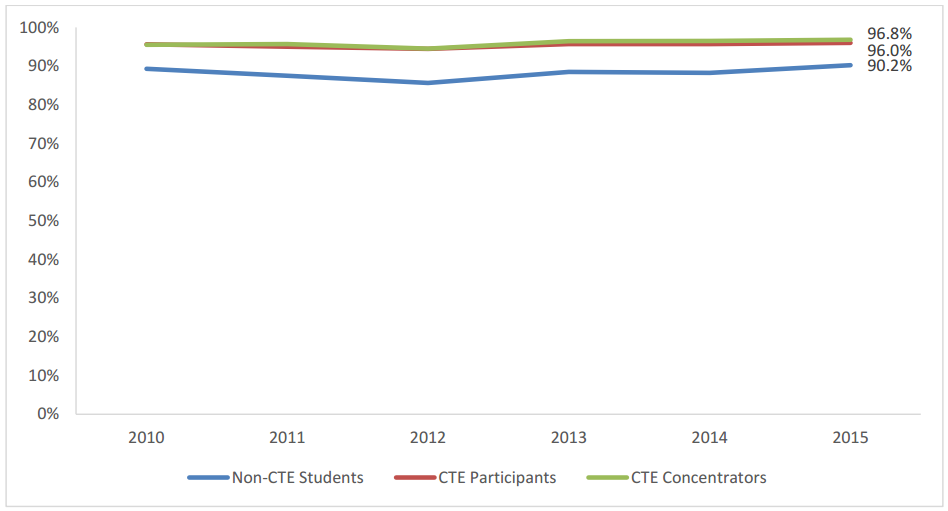![]() One of the most important considerations for learners choosing to enroll in secondary and postsecondary Career and Technical Education (CTE) programs is whether that pathway will lead to a successful career and a good salary. The new Strengthening Career and Technical Education for the 21st Century Act (Perkins V) requires states and local recipients to set goals around post-program outcomes for CTE concentrators. Several recent studies suggest that learners are finding gainful employment and increased salaries after completing CTE programs.
One of the most important considerations for learners choosing to enroll in secondary and postsecondary Career and Technical Education (CTE) programs is whether that pathway will lead to a successful career and a good salary. The new Strengthening Career and Technical Education for the 21st Century Act (Perkins V) requires states and local recipients to set goals around post-program outcomes for CTE concentrators. Several recent studies suggest that learners are finding gainful employment and increased salaries after completing CTE programs.
A study in the Community College Journal of Research and Practice analyzed data from the California Community Colleges CTE Outcomes Survey. Using three years of survey data from over 46,000 former CTE participants, the researchers found that these learners reported positive employment outcomes and obtained greater increases in wages than they were earning before beginning their program.
Another study using administrative data on a cohort of high school CTE concentrators from Washington State found that CTE learners who go on to college, compared to non-CTE learners, are significantly more likely to enroll in and complete vocational programs. They are also more likely to earn postsecondary credentials such as associate degrees and industry certifications, especially in the applied Science, Technology, Engineering and Mathematics (STEM) and public safety fields. Additionally, secondary CTE learners who do not go on to college are also more likely to obtain full-time employment within the first three years after graduation compared to non-CTE learners.
Lastly, a study of admissions and learner outcomes within Connecticut’s system of 16 stand-alone CTE high schools found that males who attend a technical high school are 10 percentage points more likely to graduate than comparable males who attend a traditional high school. Male learners attending technical high schools in Connecticut also have approximately 31 percent greater post-graduation quarterly earnings, higher 9th grade attendance rates and higher 10th grade testing scores than comparable males. There was no evidence that female learners had significantly different outcomes based on the type of school attended.
As CTE month comes to a close and states finalize their Perkins V plans and invest substantial resources in CTE programs, the findings in these three studies highlight the value that CTE programs have in positive academic and employment outcomes for learners. Additionally, these findings reaffirm the value CTE programs have in preparing learners for the real world and the many postsecondary paths they can pursue. The Washington State and Connecticut studies found that CTE concentrators were slightly less likely to go on to college than comparable learners but still more likely to earn vocational credentials, obtain full-time employment with higher earnings, and have better attendance and test scores than comparable learners. State leaders are encouraged to continue investing in these programs proving to work for learners in their states.
Other Notable Research
A report on Idaho’s education and earnings gap revealed that those with bachelor’s degrees earn substantially more in income than those with less education. Among its recommendations, the report suggests the state adopt explicit policies encouraging school districts to develop secondary CTE course sequences or certified programs focusing on two to three specific career pathways that play to their local strengths.
Brian Robinson, Policy Associate


 The Public Policy Forum, a research organization based out of Milwaukee, recently published a
The Public Policy Forum, a research organization based out of Milwaukee, recently published a  The study finds that, within the population of students that did not go on to a four-year degree, CTE students were 11 percent more likely to “achieve” than non-CTE students. According to the study, “achievement” is measured as persistence in apprenticeship programs, persistence in community and technical colleges, employment and certificate attainment. Additionally, CTE programs accommodated a higher proportion of students receiving free and reduced price lunch and students with disabilities than other non-CTE programs, indicating that CTE could be a strategy for students of all socioeconomic backgrounds and abilities to acquire the skills needed for high-demand, high-wage careers.
The study finds that, within the population of students that did not go on to a four-year degree, CTE students were 11 percent more likely to “achieve” than non-CTE students. According to the study, “achievement” is measured as persistence in apprenticeship programs, persistence in community and technical colleges, employment and certificate attainment. Additionally, CTE programs accommodated a higher proportion of students receiving free and reduced price lunch and students with disabilities than other non-CTE programs, indicating that CTE could be a strategy for students of all socioeconomic backgrounds and abilities to acquire the skills needed for high-demand, high-wage careers. 
